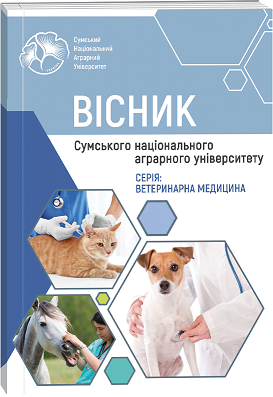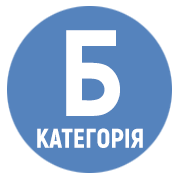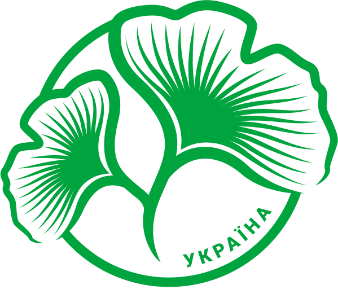EFFECTIVENESS OF A PREPARATION CREATED USING NANOTECHNOLOGY IN THE PATHOLOGY OF HYPOHAMMAGLOBINEMIA IN PIGGLES
Abstract
In the modern world, the food problem is one of the most complex problems of the world economy and politics. In solving the meat problem, the pig industry is of paramount importance, since this branch of animal husbandry allows for the production of high-quality meat products in a short time with high feed conversion. In most countries of the world, pigs as farm animals that have changed under the influence of long-term human influence are the most important source of production of highly nutritious food products. Currently, several hundred different breeds are bred in countries around the world, all of which will lead to a well-founded selection of the best animals, selection according to the desired type and targeted breeding of new generations. The variety of pig breeds allows farms in the Sumy region to have a wide choice to achieve various goals of obtaining healthy livestock with a high percentage of their survival. The main role in increasing the efficiency of the pig industry is assigned to veterinary and sanitary measures. The wide range of modern veterinary drugs allows to prevent the decrease in profitability of the farm from the death of piglets. The article presents data on the acute toxicity and prophylactic efficacy of a complex injectable preparation designed on the basis of nanoparticles of trace elements in iron deficiency anemia in piglets. The main functions of iron are associated with its incorporation into hemoglobin and myoglobin, which carry out oxygen transport, as well as into cytochrome enzymes, which provide oxidative processes. A negative consequence of iron deficiency in the body is alimentary anemia, which refers to mass diseases of animals, especially suckling piglets, characterized by impaired hematopoiesis in the form of a decrease in the saturation of erythrocytes with hemoglobin and erythrocytopenia. In addition to impaired functions of hematopoietic organs and metabolism, anemia in piglets is accompanied by impaired growth and development, as well as decreased immunity and a high susceptibility to infectious respiratory and gastrointestinal diseases.
References
2. Chen X., Zhang X., Zhao J., Tang X., Wang F., Du H.. (2019). Split iron supplementation is beneficial for newborn piglets. Biomed Pharmacother. Dec;120:109479. doi: 10.1016/j.biopha.2019.109479. Epub 2019 Sep 23. PMID: 31557572.
3. Ding H., Yu X, Feng J.. (2020). Iron homeostasis disorder in piglet intestine. Metallomics. Oct 21;12(10):1494-1507. doi: 10.1039/d0mt00149j. PMID: 32852491.
4. Dr. Kalyan Sarma. (2015). Iron Deficiency Anaemia or Piglet Anaemia [Elektronnyj resurs]. Rezhym dostupu: http://www.kiran.nic.in/pdf/publications/Mizoram/piglet_anamia.pdf.
5. Fjelkner J., Sannö A., Emanuelson U.. (2024). Iron status in piglets at three days of age and at weaning and possible seasonal effects on the blood haemoglobin levels in a Swedish outdoor pig-producing farm. Acta Vet Scand. Mar 19;66(1):13. doi: 10.1186/s13028-024-00735-z. PMID: 38504355; PMCID: PMC10953155.
6. Smirnov O.. (2015). Hypoplastic anemia of young animals (2015). Agricultural sector of Ukraine [Elektronnyj resurs]. Rezhym dostupu: http://agroua.net/animals/veterinary/diseases/g1-1/g2-1/d-230/.
7. Levchenko V.I., Golovaha V.I., Sahnjuk V.V. (2015). Laboratorne doslidzhennia krovi tvaryn ta interpetatsiia yoho rezultativ: metod. Posibnyk [Laboratory examination of animal blood and interpretation of its results: methodical manual]. Bila Cerkva: BNAU.136 s. [in Ukrainian].
8. Lipinski P., Starzyński R.R., Canonne-Hergaux F., Tudek B., Oliński R., Kowalczyk P., Dziaman T., Thibaudeau O., Gralak M.A., Smuda E., Woliński J., Usińska A., Zabielski R.. (2010). Benefits and risks of iron supplementation in anemic neonatal pigs. Am J Pathol. Sep;177(3):1233-43. doi: 10.2353/ajpath.2010.091020. PMID: 20805566; PMCID: PMC2928957.
9. Leyshon B.J., Radlowski E.C., Mudd A.T, Steelman A.J, Johnson R.W.. (2016). Postnatal Iron Deficiency Alters Brain Development in Piglets. J Nutr. Jul;146(7):1420-7. doi: 10.3945/jn.115.223636. Epub 2016 Jun 8. PMID: 27281804; PMCID:PMC4926848.
10. Lipinski P., Starzyński R.R, Canonne-Hergaux F., Tudek B., Oliński R., Kowalczyk P., Dziaman T., Thibaudeau O., Gralak M.A., Smuda E, Woliński J., Usińska A., Zabielski R.. (2010). Benefits and risks of iron supplementation in anemic neonatal pigs. Am J Pathol. . Sep;177(3):1233-43. doi: 10.2353/ajpath.2010.091020. PMID: 20805566; PMCID: PMC2928957.
11. Kondrahyn Y.P., Arhypov A.V., Levchenko V.Y.. (2004). Metody veterynarnoi klinichnoi laboratornoi diahnostyky: dovidnyk. [Methods of veterinary clinical laboratory diagnostics: a reference book]. К.:ELAN. 520 s. [in Ukrainian].
12. Mazgaj R., Lipiński P., Szudzik M., Jończy A., Kopeć Z., Stankiewicz A.M., Kamyczek M., Swinkels D., Żelazowska B., Starzyński R.R.. (2021). Comparative Evaluation of Sucrosomial Iron and Iron Oxide Nanoparticles as Oral Supplements in Iron Deficiency Anemia in Piglets. Int J Mol Sci. Sep 14;22(18):9930. doi: 10.3390/ijms22189930. PMID: 34576090; PMCID: PMC8466487.
13. Mazgaj R., Lipiński P., Starzyński R.R.. (2024). Iron Supplementation of Pregnant Sows to Prevent Iron Deficiency Anemia in Piglets: A Procedure of Questionable Effectiveness. Int J Mol Sci. Apr 8;25(7):4106. doi: 10.3390/ijms25074106. PMID: 38612915; PMCID: PMC11012493.
14. Nenortiene P., Sapragoniene M., Stankevicius A., Matusevicius A.P, Daunoras G. (2002). Geriamuju milteliu su gelezies (II) oksalatu gamyba, analize bei ju antianeminis poveikis. Ferosolis-1 [Preparation, analysis and anti-anemic action of peroral powders with ferrous oxalate. Ferosol-1]. Kaunas: Medicina. 38(1):63-8. Lithuanian. PMID: 12474720. [in Lithuanian]
15. Pu Y., Guo B., Liu D, Xiong H., Wang Y., Du H.. (2015). Iron Supplementation Attenuates the Inflammatory Status of Anemic Piglets by Regulating Hepcidin. Biol Trace Elem Res. Sep;167(1):28-35. doi: 10.1007/s12011-015-0295-6. Epub 2015 Mar 14. PMID: 25774043.
16. Prunier A., Leblanc-Maridor M., Pauwels M., Jaillardon L., Belloc C., Merlot E.. (2022). Evaluation of the potential benefits of iron supplementation in organic pig farming. Open Res Eur. Mar 21;2:11. doi: 10.12688/openreseurope.14367.2. PMID: 37645321; PMCID: PMC10445923.
17. Pu Y., Li S., Xiong H., Zhang X., Wang Y., Du H.. (2018). Iron Promotes Intestinal Development in Neonatal Piglets. Nutrients. Jun 5;10(6):726. doi: 10.3390/nu10060726. PMID: 29874829; PMCID: PMC6024698.
18. Pu Y., Guo B., Liu D., Xiong H., Wang Y, Du H.. (2015). Iron Supplementation Attenuates the Inflammatory Status of Anemic Piglets by Regulating Hepcidin. Biol Trace Elem Res. Sep;167(1):28-35. doi: 10.1007/s12011-015-0295-6. Epub. Mar 14. PMID: 25774043.
19. Qunibi W.Y.. (2010). The efficacy and safety of current intravenous iron preparations for the management of irondeficiency anaemia: a review. Arzneimittelforschung. 60(6a):399-412. doi: 10.1055/s-0031-1296304. PMID: 20648931.
20. Reichert C.O., da Cunha J., Levy D., Maselli M.F., Bydlowski S.P., Spada C. (2017). Hepcidin: Homeostasis and Diseases Related to Iron Metabolism. Acta Haematol. 137(4):220-236. doi: 10.1159/000471838. Epub 2017 May 18. PMID: 28514781.
21. Riggs A.F. (2006). Globin in every cell. Proc. Natl. Acad. Sci USA. Vol. 103, N 8. P.2469–2470.
22. Szudzik M., Starzyński R.R., Jończy A., Mazgaj R., Lenartowicz M., Lipiński P.. (2018). Iron Supplementation in Suckling Piglets: An Ostensibly Easy Therapy of Neonatal Iron Deficiency Anemia. Pharmaceuticals (Basel). Nov 22;11(4):128. doi: 10.3390/ph11040128. Erratum in: Pharmaceuticals (Basel). 2019 Jan 29;12(1):E22. doi: 10.3390/ph12010022. PMID: 30467279; PMCID: PMC6315738.
23. Starzyński R.R., Laarakkers C.M., Tjalsma H., Swinkels D.W., Pieszka M., Styś A., Mickiewicz M., Lipiński P.. (2013). Iron supplementation in suckling piglets: how to correct iron deficiency anemia without affecting plasma hepcidin levels. PLoS One. May 30;8(5):e64022. doi: 10.1371/journal.pone.0064022. PMID: 23737963; PMCID: PMC3667775.
24. Stangl G.I., Roth-Maier D.A., Kirchgessner M.. (2008). Vitamin B-12 deficiency and hyperhomocysteinemia are partly ameliorated by cobalt and nickel supplementation in pigs. J Nutr. Dec;130(12):3038-44. doi: 10.1093/jn/130.12.3038. PMID: 11110865.
25. Wan D., Wu Q., Ni H., Liu G., Ruan Z., Yin Y.. (2019). Treatments for Iron Deficiency (ID): Prospective Organic Iron Fortification. Curr Pharm Des. 25(3):325-332. doi: 10.2174/1381612825666190319111437. PMID: 30892157.
26. Zhang Y., Dong Z., Yang H., Liang X., Zhang S., Li X., Wan D., Yin Y.. (2020). Effects of dose and duration of dietary copper administration on hepatic lipid peroxidation and ultrastructure alteration in piglets' model. J Trace Elem Med Biol. May 27;61:126561. doi: 10.1016/j.jtemb.2020.126561. Epub ahead of print. PMID: 32480055.
27. Zhang H., Li Y., Wang T.. (2015). Antioxidant capacity and concentration of redox-active trace mineral in fully weaned intra-uterine growth retardation piglets. J Anim Sci Biotechnol. Nov 19;6:48. doi: 10.1186/s40104-015-0047-7. PMID: 26587234; PMCID: PMC4652383.

 ISSN
ISSN  ISSN
ISSN 



